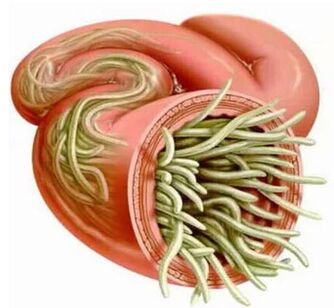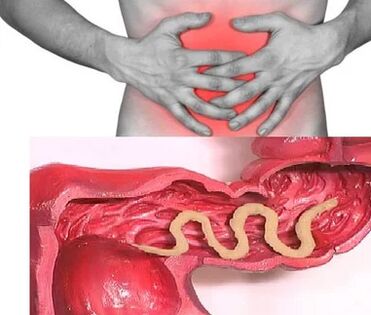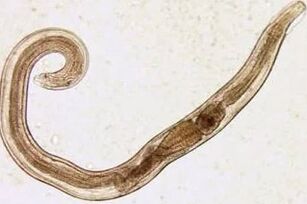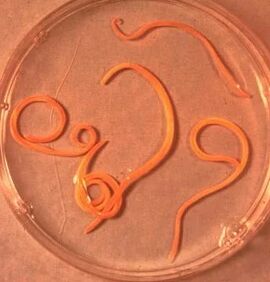To date, science is known about 280 types of worms that can develop and live in the human body, parasiting in several organs and tissues.The frequency of human infection depends on the climatic and socio -economic conditions of the specific territories (in underdeveloped countries, especially in those located in the tropical and subtropical zone, the level of parasitic infections is much higher than in economically developed states).
Methods of human infection with helminths:
- Bioelmintosis (animal infection).
- Contagioine Helminthosis (transmitted from person to person).
- Geogelmintos (diseases caused by parasites carried out by one of the vital cycles on Earth).

Factors that affect the manifestations of helminthiasis
The parasite penetration method in the body:
- The degree of adaptation of the Helminto to the human body;
- The density of the population (quantity) of parasitic individuals;
- The worm habitat (tissue parasites live in the thickness of soft tissues, and cleaning lives in the holes of the hollow organs).Some helminths in several phases have educational and fabric forms.The stages of larvae and in development of worms, as a rule, cause more pronounced pathological changes.
In the absence of reinfection, the number of adult parasites in the human body does not increase.This characteristic significantly distinguishes the helminthic invasions of diseases caused by bacteria, viruses, fungi and simple organisms.
Worms in humans: symptoms
Helminosis is a disease that is characterized by 2 stages of the course (acute, from two weeks to two months) and chronicle (from several months to several years).
Acute phase symptoms of helminthiasis
The first signs of the disease can manifest at different times (most of the time after 2-3 weeks, with ascaridosis after 2-3 days, and with rowairiosis, the incubation period can last 6-18 months).
In the acute stage of the parasitic invasion, the most characteristic symptom is an allergic reaction (antibodies are generated in migratory larvae antigens of parasites).Often, eruptions with itching, prone to the recurring course, have an increase in the recurring course, the regional lymph nodes appear in the skin and the appearance of generalized or local edema, muscular and joint pain can occur.In addition, the migratory larvae of the parasite can cause chest pain, cough, suffocation suffocation, stool disorders, nausea and vomiting.
At the same time, the acute phase of helminthiasis can be accompanied by more serious disorders (serious forms of pneumonia, hepatitis, allergic myocarditis, hepatostosogalia (an increase in liver and spleen).
In the blood, the amount of eosinophils (eosinophilia) and the normal quantitative relationship between protein fractions (disputeinemia) increases.

Signs of chronic helmintiasis
The symptoms of the chronic phase depend directly on which organ is "populated" with parasites, as well as their size and quantity play an important role.
Then, when parasitic in the intestines of individual individuals, the disease can occur asymptomatic (with the exception of cases of infection with very large parasites).The characteristic features of the chronic phase of intestinal helminthiasis are dispute disorders.In children, acenoarotic and pain syndrome is more pronounced.With mass invasion, ascardians, intestinal obstruction, mechanical jaundice and pancreatitis is possible.
By consuming all the necessary substances for their vital activity of the guest's body, helminths cause digestive disorders, violations of the absorption of vitamins, minerals, carbohydrates, proteins and fats.At the same time, the products of the life of worms inhibit normal intestinal microflora and reduce the immune forces of the body.
In people suffering from helminthia, due to weakened immunity and the improved process of cell division (consequences of constant restoration of tissue parasites), the risk of malignant tumors increases significantly.
Types of parasitic helminths in the human body
The causal agents of human helinesis are 2 types of worms: round (nematodes) and plans (tape and dishes).
Round worms
Intestinal Lombriz
The parasites that are the cause of enterobiosis are small thin cavity worms (up to 10 mm) that have grayish white spots.The infection occurs in a food way (through the mouth).The reason for this is the dirty hands.Parasite eggs can be on the floor, in the wool of infected animals, vegetables and unwashed fruits, etc.At the same time, with enterobiosis, cases of self -expiration (especially in children) occur as a result of combing areas and posterior egg swallows are not uncommon.The cutting larva develops within two weeks in the digestive tract.By becoming an adult individual, the parasite worm in the lower parts of the small and upper parts of the colon.

Askarida
Askaride is a great parasite of a red yellow spindle shape, which reaches an adult state of 40 cm (females) and 15-25 cm (males).Without a cup of suction or other fixing devices, Ascaride can move independently towards food masses.The eggs established by the female parasite are distinguished with feces.
Acadosis infection occurs in case of swallowing ripe eggs along with water or vegetables and unwashed fruits in which there are soil particles.After the eggs penetrate the intestines, the mature larvae leave them.Then, introducing into the intestinal wall, they reach the heart according to the blood flow, and from there they fall into the lungs.Through the pulmonary alveoli, the Ascarida larva through the respiratory tract penetrates the oral cavity again.After swallowing repeated, the parasite arrives at the small intestine, where it becomes an adult.The worm lives for 12 months, then dies and stands out with feces.In the intestines of an owner they can live both one or more hundreds of people.
Vlashev
Vlasov, the causal agent of trichocephah, is a white helminto that parasites in the initial part of the large intestine and reaches a size of 4-5 cm.The parasite is fed by the blood and tissues of the rectal mucosa.
Sollozo -headed eggs established by the female on the intestine walls come out along with the feces.Its development occurs in the environment (optimally on the ground).Eggs with parasite larvae penetrate the body with a food shape, through dirty hands, with water or unwashed vegetables and fruits.

Tricinella
The causal agent of trichinelosis is a small round helminto that reaches 2-5 mm in length.The infection occurs when the use of poorly fried meat (pork, bear puppies, wild boar).Penetrating the intestines, the parasite larva in 3-4 days mature in the state of the sexually mature individual.The life expectancy of the worm is 40 days, after which the parasite dies.Condling the intestinal wall, the larvae penetrate the bloodstream and are transported in all organs of the human body, establishing in the muscles.In this case, respiratory and facial muscles, as well as the muscles-docked of the limbs, are often affected.
In the first days after the invasion, patients complain of abdominal pain.Then, after approximately 2 weeks, the body temperature increases to 39-40 s, eruptions appear with hair hair, muscle pain develops and the face swells.In this period, in the case of mass infection, there is a significant risk of death.After approximately a month, recovery occurs.The parasite is encapsulated spirally, after which it dies within two years.
Anillostoma and no core
These two parasites are similar to each other by biological characteristics, as well as in the diseases caused.With this, it is customary to join them under the general name (Ankyostoma).The worms that reach 10-15 mm lengths are parasitized in 12-P.intestine.It should be noted that this is one of the most common parasites, but at the same time, it rarely identified.The worms of the worms penetrate the human body through the skin when they are in contact with the infected soil.In addition, when entering the bloodstream, they, like ascárides, migrate to the lungs, and then, through the bronchi, along with the sputum jumping, to the digestive tract.Parasite anylostoma in the intestines, united to the intestinal wall.A parasite that is eaten exclusively with blood bites the blood vessels that pierce the mucous membrane, injecting an anti -impover component there.During the day, an adult can absorb 0.05-0.35 ml of blood on average.Therefore, the most characteristic symptom of this helminthiasis is iron deficiency anemia, as well as a change in the ratio of protein fractions (disputeing).
Flat worms
Wide tape
This is one of the largest helminths that reach a length of 10-20 meters.The disease caused by this parasite is called dipilobotriosis.The worm development cycle begins with freshwater fish or crustaceans.The larva enters the human body, which is the final owner of a wide tape with caviar or infected fish fillet.Upon reaching the thin intestine, the parasite is linked to its wall and for 20-25 days a sexually mature individual grows.
Hepatic bacon
A parasite that causes opistorchiasis is a flat worm that reaches a length of 7-20 mm.It should be noted that more than 50% of cases of infection with a liver dish (it is also called cat biconometer) falls to the inhabitants of Russia.The parasite larvae begin to develop after the eggs fall into fresh water (of the swallowed snails).Then they penetrate the fish of the fish (tent, cross tent, kiss, cockroach).Human infection occurs when it eats infected fish that has not suffered enough heat treatment.The Larva of the hepatic pump of the small intestine penetrates the bile ducts to the gallbladder, fixing there with two cups of suction.
Bull and pork
These almost identical parasites in structure reach a length of 5-6 meters.Infection with youriarinmosis and tosiasis occurs due to the use of livestock meat or meat infected with Finnish (one of the intermediate forms of helminthiasis).The visible Finnish ones, presented in the form of whitish bubbles, which reach 0.5 cm in size, are linked to the wall of a person's thin intestines and in 3 months they become an adult individual.The parasite of the strip, which consists of more than 2000 segments, is growing constantly.At the same time, the final segments that contain eggs come out and move independently along the colon to the anal opening, and then leave the anal, or stand out in the external environment along with the feces.The most characteristic symptoms of helminthiasis are a violation of the digestive tract.
Echinococcus
For this parasite, a person is an intermediate host.The parasite worm in the human body in the form of Finnish.The final owner of Echinococcus is a wolf, a dog or a cat.The infection occurs in food in contact with animals and environmental objects, with the handful of Echinococcus eggs.After entering the intestines, the oncospheres (larvae of six black) develop from them.From the intestine they penetrate the bloodstream and are transported throughout the body.
Alveokokk
This parasite, which is considered a variety of Echinococcus, is the cause of one of the most dangerous Helmintiae (alveococosis), which is similar in gravity with cirrhosis and liver cancer.The infection occurs with the penetration of the oncosphere (eggs with mature larvae) in the intestines.There, the embryo leaves the egg and, introducing into the intestinal walls, penetrates the bloodstream.In addition, with a blood flow, the parasite spreads through all the tissues and organs of the body (more frequently located in the liver).It is there that the main stage of development begins in the larvae (a multiple cameras bubble, Laurelocyst)).Each camera contains an embryo head of a parasite, which continues to be gradually developing.Lavcistas are very aggressive formations that grow constantly due to bubble increases, and also have the ability to germinate in the liver, such as cancer metastasis.
Helmintiasis diagnosis
The diagnosis of helminical invasions includes the following events:
- An exhaustive collection of an anamnesis that helps discover the possible causes of infection;
- Stool studies, blood, 12p intestines content, rectal and perianal mucus, muscle tissue, pulmonary sputum, bile.During the analysis, eggs, segments or fragments of parasites can be detected.At the same time, the highest content of blood eosinophils is also a signal about the presence of helminthiasis.
- In the diagnosis of diseases caused by the stages of tissue larvae or parasites, serological studies are carried out (Elisu, RSC, indirect agglutination, immunofluorescence analysis, etc.).
- To identify helminths that affect liver tissue, ultrasound, TC and endoscopic studies are prescribed.
Worms in humans: treatment
In the acute phase of a parasitic infection, detoxification and desensitizing therapy are prescribed to the patient.In a severe course of the disease (hepatic trematidosis, trricineosis), glucocorticoids are used according to medical indications.
As specific therapy medications, taking into account the nature of the pathogen, chemotherapeutic agents are prescribed special antihelmintic.
At the same time, the patient is recommended to take antihistamines and integrosorphtes.The final stage of treatment includes the use of probiotics that normalize intestinal microflora.
A special savings diet is also prescribed (food must be easily digestible and contain little fat).
During the period of antihelmintic therapy, the patient needs strict adherence to personal hygiene (to avoid infection).At the same time, with many Helmintiasis, all family members and people infected in constant contact must undergo treatment.





















